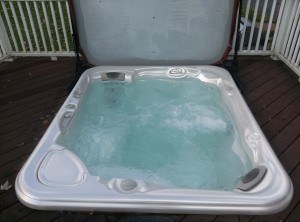WifeGirl and HomeOwnerMan work very well in the kitchen together. WifeGirl is usually the Master Chef, while HomeOwnerMan is comfortable in his role as Sous-Chef. There are a few notable exceptions to this rule, however.
Pierogies have been in my family for as far back as we can remember. My mother learned from my grandmother, and I learned from both of them. So, when it comes to pierogies, I am generally in the driver’s seat here. Which suits WifeGirl just fine; she has enough running things the rest of the time.
The great thing about pierogies is that they are something that does not follow the rule “Too many cooks spoil the broth.” In fact, there are so many jobs involved that it makes for a very social time to make a large batch. Over the years I have made them with many friends, and we started to have PierogiFest every year because of the social aspect of it. Throw in some prosecco and you’ve created a whole new tradition. In fact, we have learned that we prefer to hold some sort of event when we have people over rather than to just entertain for the sake of entertaining. It has been received well. We did a scotch tasting a couple of years ago, for example. This was popular with scotch lovers and novices alike because it gives everyone a sense of purpose and belonging.
Anyway, here are the pierogies as my family makes them, and including a few things I’ve learned over the years.
Pierogi Recipe
Notes from 2017 Pierogifest: We used the pasta roller on a setting of 3, but 4 probably would have been better, because a lot broke. Remember to not overfill them. 5 cups of flour = 25 oz if using a scale. I found you can start the recipe with 30 oz flour per batch of dough. If you add the liquid ingredients together and mix them well, you can put the full 30 oz of flour in at once and the dough hook will do a great job of getting it mixed and pliable, with only small amounts of added flour needed.
From “The Frugal Gourmet on our Immigrant Ancestors” and my Grandmother Anna Semanko Dzwonczyk
(This is really light and tasty dough which uses sour cream as the liquid element. I make mine in a mixer one batch at a time. Each batch makes about 7 dozen pierogi.)
2 cups sour cream
5 cups all—purpose flour
2 tablespoons melted butter
2 eggs plus 1 egg yolk
2 teaspoons salt
2 tablespoons vegetable oil
In a large bowl, mix all the ingredients and knead into soft, pliable dough, adding flour until it is no longer sticky. Cut in half, and let rest, covered, for about 10 minutes. Roll out each half into a thin circle. Using a drinking glass cut the dough into circles and fill them with the desired filling. Place less than a tablespoon of filling in the center of each circle and fold over. Wet the edges with a little water, and press into a half moon. Seal with a fork. Cook for 20 minutes in boiling salted water. Drain. They can be pan—fried in butter at this point, if you wish, for a really tasty finish.
***A couple of suggestions and hints from watching Anna Dzwonczyk do this:
- She cut her dough into 3” squares and folded them over into smaller triangles. (I prefer the circle/half-moon technique myself).
- Roll the dough out pretty thin, like 1/8 or 3/16”, in other words, as thin as possible without “filling herniation”, and liberally flour the dough as you roll it out.
- Rather than pan-frying the pierogies, cover the boiled pierogies in melted butter and browned onions.
- If you are freezing them for future use, don’t make one big hockey puck like Paul Sleph and I did one time. Here’s what you do: Sprinkle cookie sheets with a liberal amount of corn meal. Lay out the pierogies in rows across the pan (or columns down the pan if you think they’ll taste better.) Freeze them until they are set, and then bag them in labeled plastic bags.
- I use a pasta roller and ravioli forms to make the pierogies. This makes the pierogies more uniform so that they all cook at the same rate. If you are doing it this way, start at the thickest setting, adding flour with every pass and getting down to a thin setting (3 on my machine). Place the dough over the ravioli form, fill them, wet the seams, and lay the 2nd piece of dough over it. Seal them by passing a rolling pin over them. Poke a single toothpick hole in each one to allow trapped air to escape when cooking. This keeps them from bursting.
Anna’s favorite Potato and cheese filling:
3/4 lb. sharp orange cheddar cheese, grated
3 potatoes, peeled, boiled, and mashed
While the potatoes are still hot, add the cheese and mix together well. Cool in the refrigerator until room temperature or below. Fill pierogies. This will fill about 7 dozen pierogies.
Anna’s prune filling:
(I know this sounds gross, but I guarantee you’ll like it.)
1 box pitted prunes
1 tablespoon sugar
Stew the prunes until soft in a saucepan in just enough water to cover them. Drain. Add about 1 tablespoon of sugar, and mash the prunes until they become a thick paste. Use as filling. This will fill about 3 dozen.
Barbara Gatta (of Brooklyn)’s apricot filling:
(my personal favorite, and Florence’s too)
1 pkg of dried apricots
~1/4 cup sugar
Stew the apricots, in just enough water to cover them, until soft. Add the sugar (more or less to taste) until the mixture is sweet. Mash. Use as filling. This will fill about 3 dozen.
Florence Dzwonczyk’ and Paul Sleph’s Sauerkraut Filling
1 14 oz. can of Sauerkraut
¾ bottle beer.
Empty the sauerkraut into a sauce pan and add the beer. Finish the beer. Heat the sauerkraut for 10 minutes on medium heat. Allow to cool, and then drain thoroughly through a colander. Use as filling. This will fill about 3 dozen.
Joann Strnad’s Suggestion – Pumpkin Filling
1 3lb. pumpkin, roasted, seeded, pureed, and drained (will amount to about 2 cups. You can also use canned pumpkin if you want – the color will be a lot bolder. Substitute squash, or even yams or sweet potatoes, if you like.)
1/2 cup chopped cooked bacon
2 whole heads of garlic, roasted until soft and dark golden
1/2 cup grated Parmesan cheese
1/2 tsp. pepper
1/4 tsp. nutmeg
Salt, to taste
I used a food processor, but you don’t have to. I prefer a uniform texture in my pierogies, and this is the easiest way. You can just mash everything together if you like – that’ll work perfectly well too.
Combine pumpkin, bacon, garlic, cheese, pepper, and nutmeg. Mix well, then taste. Adjust your seasonings if need be. This would be the time to add salt if you feel like it.











